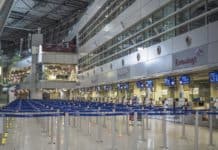
The drama of Rio de Janeiro is in its steep mountains kissing the sea. The city was literally built around these sheer granite peaks, its roads tunneled through them. Apartment windows face directly into to their sides. In other places in the world, there’s a gradual buildup to reach a mountain; here, it just appears at full height on the next street corner.
The mother of Rio’s many mountains is Corcovado, recently named one of the New 7 Wonders of the World by TripAdvisor. At its highest point, the soapstone statue of Christ the Redeemer blesses the millions, arms outstretched, perfectly carved hands 10 feet in length.
The city is bracing for next year’s Olympic Games, with evidence of construction throughout the downtown area, roads being rerouted and a new metro underway. Most of the activity will take place 45 miles away in the Barra da Tijuca, but Rio will be bursting at the seams with an expected half-million visitors.
Though our DMC warned us to be aware of petty crime while walking around the streets, our experience was just the opposite when a taxi driver actually returned a left cellphone to my colleague. There was a strong police presence along the beach and the only people out on a brilliant Sunday morning were the thousands of joggers and exercisers who overtake Avenida Atlantica, which closes to traffic that day.
The 245-room JW Marriott Hotel has one of the best locations in the city, with rooms overlooking the crescent-shaped Copacabana Beach. The property has long been one of the top choices for incentive groups, along with the majestic Copacabana Palace. Its look is modern but classic, with dark wood furniture and rich velvet upholstery. The hotel’s Presidential Suite hosted President Obama in 2012 and the staff members still proudly share their stories of his visit. There are 12 meeting rooms, with a ballroom that can accommodate 250. A highlight was the rooftop, high above the world’s most recognizable beach, with Sugarloaf off in the hazy distance–unquestionably a million dollar view—accommodating 200 for a reception.
A must-do experience for a group is dinner at a traditional Brazilian churascarria, or steakhouse, where waiters arrive at the table with fine cuts of meat and sausages (22 different ones at Porcao, the restaurant we visited), slicing servings from the rack for the eager diners to pick off with their tongs.
After a couple of days in Rio, it was on to Sao Paulo, Brazil’s largest city with a population of 11.3 million, for the Forum Eventos, a gathering of meeting managers organized by Revista Eventos magazine. Sao Paulo is a city of contrasts, with striking glass office towers, upscale shopping malls and Ferrari dealerships sitting just blocks away from crumbling homes. Brazil’s business center, the city hosts hundreds of fairs each year at Expo Center Norte, the main convention facility, and is headquarters to many multinational corporations. Hotels are primarily business brands, such as Pullman, Melia and Grand Mercure.
Our group had the once-in-a-lifetime opportunity to experience a completely empty Allianz Park, a brand-new soccer stadium that seats 45,000, most of those seats beneath an overhang. One area can be closed off for more “intimate” gatherings of 15,000. The excitement of being a single group in such an enormous structure is palpable, as guests make their way down the many stairs to catch the view from below and pose for sefies to prove they have been there. The stadium had just hosted 45,000 for a game the night before, but there was no evidence of them ever having been there.
Like so many sights we witnessed during this short visit to Brazil, just amazing.










